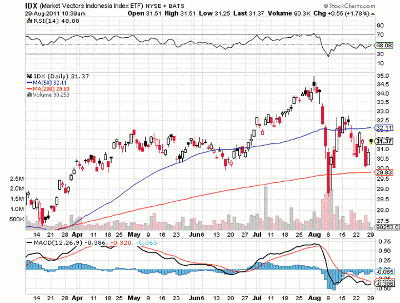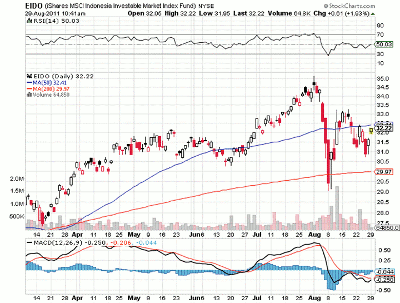The top emerging market that nobody is talking about is Indonesia, which has produced solid returns amid difficult conditions this year. These two Indonesian ETFs represent the best ways to profit if the trend continues.
While 2011 may have gotten off to a good start for many equity markets prior to this summer’s roller coaster, many equity markets across the globe are flirting with negative return. Worries over the fallout from a downgrade of American debt have now shifted to concerns over more stimulus either by the Federal Reserve or by Congress. Yet more measures coming down the pike seems uncertain at best, leaving the American economy to muddle through its current economic malaise.
Meanwhile, in Europe, things aren’t much better, as the debt contagion striking the peripheral markets of Spain, Greece, and Italy is now threatening to strike core nations such as France and Germany as well.
As a result of this broad uncertainty and the widespread fears over a double-dip recession in the US, many investors have pulled out of stocks and have looked to products such as gold or Treasury bonds as a way to wait out the storm. This has pushed gold to record highs and caused yields on American debt to reach levels previously unthinkable with ten-year bonds yielding less than 2.25%.
This flight to quality has been especially devastating for emerging markets, as developed-market investors pull cash out of these stocks in order to stash money in safer havens instead.
Yet, while emerging markets have been slumping, a couple Indonesia ETFs have managed to hold their ground and even prosper in this difficult environment.
Market Vectors Indonesia Index ETF (IDX)
Even in their recent volatility, so far year-to-date, IDX and the iShares MSCI Indonesia Investable Market Index Fund (EIDO) are the only two products in the entire emerging market ETFdb category to be in the green since the start of this year.
In comparison to the broad-based Vanguard Emerging Markets VIPERs ETF (VWO) or iShares Emerging Markets Index Fund (EEM), which contain a wide swath of emerging markets in its holdings, both IDX and EIDO have significantly outperformed. VWO is down almost 14% year-to-date while IDX has gained 5.9% and EIDO has surged by 8.6%.
iShares MSCI Indonesia Investable Market Index Fund (EIDO)
NEXT: Why Indonesia Is Holding Up So Well
|pagebreak|Many investors are likely wondering why Indonesia, a relatively poor country, has been able to gain, while others, even its neighbors in the region, have not. While there could be a number of reasons for this outperformance, the structure of the Indonesian economy is likely at the heart of the issue.
That is because Indonesia is much more dependent on internal consumption than many of its neighbors in the region. Countries such as Thailand and Malaysia, which are also rapidly emerging, rely on exports to fuel their growth almost exclusively.
While exports are certainly a crucial part of Indonesia’s economy, the nation isn’t nearly as dependent on the outside world as some of its Southeast Asian counterparts, as domestic consumption makes up more than half of economic activity. This can be an extremely good thing in times such as these when demand from Western markets is declining, and it has likely helped to insulate IDX and EIDO from the worst of the crisis.
Additionally, Indonesia remains a huge producer of a number of key resources that have been in demand as of late. Thanks to a sinking greenback, many of Indonesia’s main exports are still in demand by other nations in the region, further helping to insulate the country from the global economic malaise.
For example, countries such as Taiwan are sending electronics to the West while Indonesia is pushing products like copper to nations such as China. Obviously, demand for discretionary goods in the US has fallen, but China’s robust demand for natural resources has not, making the type of Indonesia’s exports key to its recent success as well.
With that being said, the country is taking steps to increase the number of factories and other centers of production across the nation. Given the extremely low costs of labor in Indonesia, as well as the never-ending search for higher profit margins by many companies, the country is quickly becoming an increasingly popular destination for many firms.
It is relatively close to other key production centers in Asia, but often has labor costs that are but a fraction of other nations, helping to keep unemployment well below 4%.
Furthermore, it should be noted that Indonesia has a debt-to-GDP ratio of just 26%, nearly one-third the level of many developed nations. Thanks to this flexibility, Indonesia can freely spend on infrastructure projects to help boost jobs and growth, possibly making the country an even more attractive location for businesses in the future. “The global economy is heading downwards but we will fare better,” said Finance Minister Agus Martowardojo in Jakarta. “Everything is in good shape—economic growth, inflation, exchange rates.”
So for investors looking for more emerging markets exposure, either one of the Indonesia ETFs could be an excellent choice. The country remains well positioned in the crisis and could be a strong performer once the storm passes.
Expenses and volumes are pretty comparable for the two products, but there are some differences in the holdings that investors should note before picking either one of these products for their portfolio. EIDO holds nearly twice as many securities as its more established counterpart, but it is nonetheless more top heavy. Both funds do offer heavy allocations to financials, energy, and consumer cyclical firms, but experience rather large deviations after that among their smaller sectors.
Either way, investors are bound to get relatively well-diversified exposure to one of the world’s most populous countries that is often not included in heavy doses in many other emerging market funds. Thanks to this, and Indonesia’s incredible performance so far this year, a closer look at EIDO or IDX may not be a bad idea for investors who think that recent trends can continue.
By Eric Dutram, contributor, ETFdb.com






















